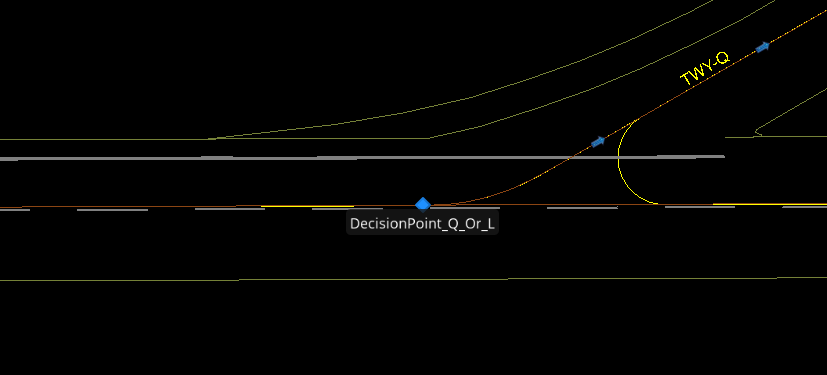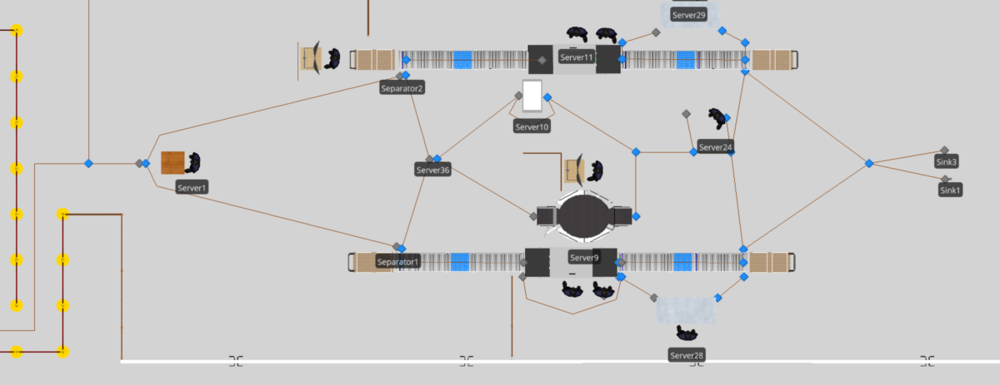Search the Community
Showing results for 'buffer transfer node'.
-
This is something I have been meaning to implement for a while, and now have finally decided it needs to be done. I have a submodel, and due to the limitations of the software can't transfer it into the submodel and keep the model clean. I followed advice posted here, and have made the submodel seize the worker and send it to a node in the higher level model... while the submodel is in progress. Is there a nice efficient way to have the worker/vehicle (vehicles are the new worker in terms of having all the functionality i require) able to interrupt the submodel and either remember where it was up to and return after break... or allow another seize request for a different worker, and have that worker continue where it was left off?
-
Hi all, how would you approach this model? Workers are transporters and must be present at the servers to supervise each step. For now I have one worker and am using a personal edition of Simio. Server1 is an observation microscope where entities pass through a survey step. Server2 is a robot dispensing glue that has a finite window of appropriate elasticity after mixing. I started my model with a version very similar to the MoveableOperator where my worker goes back and forth between two servers running 6 entities individually before switching... six being the number of entities we believe can be processed with one batch of glue. When trying to model the delay step of glue mixing (ideally with worker movement to a separate node or location) I thought to add it as the first in a task sequence at Server2 with the condition that it only need to be applied when the server buffer was full of the 6 entities. This seemed to not fit well with the priority decisions that the worker already had for movement and the worker stalled. Basically, how would you model the fact that every 90 minutes we need a 15 minute delay for glue mixing and that once the glue is mixed the priority needs to be at Server2 until glue elasticity runs out?
-
Dear all, I would like to know how to model the following problem: At creation, each entity gets a destination node. But 5 % of the entities have to make a stop-over at a certain node called "security check". After going through "security Check" the entity has to go to the destination he gained at creation. How to model such a "stop-over"? Thanks!
-
Hi LizMB, Without evaluating your model in detail, that error is due to a transfer not being completed (transfer request while entity is still being transferred previously). It is typically when you make use of a transfer step and either not end the transfer (using and "End Transfer" step), before transferring it again or when Simio attempts to transfer the entity (due to inherent worker/node/vehicle logic) before the end transfer is completed. It could also be if you interrupt something before a transfer action has completed. What also happens is when you have processes executing e.g. On-Entered and the same entity executes one or more such processes at the same time, resulting in a inherent transfer request before the previous has completed. It could be a matter of timing or the sequence of events, or a problem in your logic. When you are using a transfer step in your logic it is useful to have a process with an End Transfer step that is either subscribed to certain events or executed on an event triggered e.g. StationName.Entered. If you were to interrupt a process/action, you can either fire the trigger event or just use logic to test whether the entity has transferred. With an add-on process it is best to understand the sequence of events happening in the Simio logic and ensure certain logic gets completed first or that you don't have parallel requests at the same time. As you can see there are multiple ways to address something like this and your approach depends on your logic and the system being modeled. Good Luck. H
- 2 replies
-
- transfernode
- worker
-
(and 1 more)
Tagged with:
-
I have 2 transports delivering entities to 3 servers. What should be happening is that Transport 1 loads entities to capacity (12) then moves to Server 1 and delivers all of the entities (12). Transport 2 should load 12 entities and deliver all 12 to Server 2. Transport 1 returns to Home Node and loads 12 more entities for delivery to Server 3... and so on. However, what is happening is that both Transports are loading 12 entities then moving to Server 1 and delivering 4 entities each, then on to Server 2 and repeat and so on. I have removed and added servers to confirm that for some reason the Transports are delivering 1/#ofServers of their total capacity, conducting all of their deliveries and then returning to home once empty. I have limited the timepath to each Server to only allow 1 Transport at a time, but then Transport 2 just waits at the Home Node until Transport 1 is on its way to Server 2. Then it moves to Server 1 and just ends up one node behind Transport 1 at all times. The dispatch logic: (Server1.InputBuffer.Contents.NumberWaiting <= 12)||(Server2.InputBuffer.Contents.NumberWaiting <= 12)||(Server3.InputBuffer.Contents.NumberWaiting <= 12); set at Smallest Value for Selection Goal; Selects from a List of all Server Nodes.
-
A quick solution to force all entities to get dropped at the same place is to add an add-on-process when an entity is loaded. which Checks if the entity is the first item in the vehicle and if not set its destination node to the first item. Decide: Token.associatedobject==Token.ContextObject.Vehicle.RideStation.Contents.FirstItem If False -> SetNode: Token.ContextObject.Vehicle.RideStation.Contents.FirstItem.ModelEntity.destinationnode a more elegant solution would probably involve batching the entities into a bucket that would then get transported to the destination. Upload 11.1.21.spfx
-
Thank you gocken. This is so helpful. It makes things much simpler. I created an example with an entity which uses the worker as a transporter to go to the parent node at the combiner. the batch is created and they move on together. This seems to work well. But, I need to be able to perform the batch selection in a process. This is where things keep falling apart for me. I made the combiner match on member and parent, giving the entities a state variable set to True if those items were to be batched. I want to set this in an add-on process. Further, I need to be able to trigger this process when either a parent or a member entity enter their input buffers. I have an example attached that uses the add-on process. Once the parent enters the input buffer, the parent can choose what to batch. The batched items move on to server1 and the separator. Then, the worker (entity and transport) return to parent input of combiner, but it's empty. The unbatched entity goes to server2 (just to ensure it arrives after the parent). I thought it would leave server2 and trigger an add-on process on arriving at the member input node, but the add-on process is triggered when still at the server2 output node. So, in the add-on process, I transfer the parent to the parent input node (just to get the parent to kick off its own add-on process, but it doesn't know where to search for the member entity because it's still at server2. How do I get a process to fire to determine what to batch whenever either a parent or a member arrives? using combiner.spfx
-
Hello, I want to bring a box in front of two server. I want the units in the box to be the entity for the two servers. How can I do that ???
-
Hi, I would like an entity to wait at a certain transfer node until a server is idle. I know I am supposed to add a process to that node that says that, but I couldn't come up with an expression. Thanks in advance
-
Hello, I hope everybody is doing great! So I am trying to simulate a system that have different servers with different selection rules, all the customers wait in the same waiting area/queue. What I want is that all servers search in a global Input Buffer Queue (or Storage Queue) every time they are available and choose the entity based on their selection rule, or a process that send the entities to the their right destination whenever a server that can process them is available. I have attached a sample model less complicated than my system for what I want with further description of the objects, but it doesn't run properly at all, it is just for clarification. The first challenge is that I want the selection rules of the servers to choose from the global input buffer not the input buffer queue of their own, I am not sure how to do that or if it is applicable. The second challenge is that some servers have complicated selection rules (as shown in the sample model) I was able to represent these rules in a separate model by holding the entities at a node until the condition is met, but when I have multiple servers in some cases these entities can go to another server, so the rules conflicts with each others (unless we were able to integrate both rules together). Also, having multiple stations or storage queues with different ranking rules for each server do not work because when the entity enters the queue it will get stuck there even if another server was available and able to serve it. If you believe there is another way to represent the system with Simio I would appreciate your suggestions. Thank you for your time GlobalQueue.spfx
-
I constructed a simple model with a single server where I used a rate table for arrivals. The server block capacity was fixed at 2. When I run this model by hand, I see that maximum holding time for the input buffer of the server is just about 24 minutes every time (but the same exact number), just as it would be if the arrival rate was constant throughout a 24-hour period. However, when I run an experiment where I defined the Server1.InputBuffer.Contents.MaximumTimeWaiting as the response variable, the result is 40 minutes for the scenario where the server capacity of 2 is 40 minutes.(I am using version 5.91) I am wondering 1) if I am confusing two different quantities (maybe the maximum holding time result is averaged by dividing by capacity, but that would be a bug, because the capacity should have no effect on the input buffer) or 2) if the randomization seed is the same for every run that I do by hand, which must be the case, because when I reduce the required replication count to 1 for the experiment, I get the same exact result for the single run that I do by hand. If that is the true reason, then I must ask where to change the randomization seed for every run.
-
Is there any way to clear output buffer of source at particular time of simulation (like every 165 th hour and its multiple)
-
Hello, One approach you could use is have an initial capacity of 0 at the Enfriado servers to hold the entities in the input buffer queues. During the entered event of the input nodes of the Enfriado servers, you could insert the tokens into a storage element. And a "controlling" server could then use process logic triggered by a scan step that determines if the number of entities in the input buffer queues are greater than 1, that would perform a search of those Storage.queue for the Entity with the longest processing time. To determine the processing time, one has to track it. The real state variable on the ModelEntity, ModelEntity.RealStateVariable, would be created and TimeNow would be assigned before processing. Then that is assigned TimeNow - ModelEntity.RealStateVariable after it processes at the previous servers. Once the entity is found from the storage queue, a transfer step would take that entity and pass it to the Cortador server's input node. The search step could look for Candidate.ModelEntity.RealState1 using a Backward search type and a limit of 1. Once the entity is transferred, the entity can be removed from the storage element. Judy
-
Hi I want to randomly send one entity to 3 diferent nodes, but each entity can only visit each node once. I.e., Entity 1 will travel 'Source -> NodeA -> NodeB ->NodeC -> Sink' and entity 2 will travel 'Source -> NodeB -> NodeA ->NodeC -> Sink' and so on. Right now I'm using Routing by sequence, but it only verifies the rule to visit every node but not randomly... So the last nodes from the list are becoming the bottleneck when they are not. I could also create individual sequence tables for each possibility, but in my model I Need around 1000 diferent routes so that's not a good Option. Any idea? Thanks!
-
Hi, I'm working on an airport simulation, this is my first simulation, i have a transfer node that has one income link and two output links, so I would like to know if there is a way that depending on certain Entinty's boolean state variable, whe passing throught the tranfer node if the state is true set and specific outbound link and if it is false then set the outbound link rule by link weight.
- 1 reply
-
- routing
- state variable
-
(and 1 more)
Tagged with:
-
Varying Path Length and Moving Servers
gocken replied to DavidMann's topic in SI General Discussions
You can place some enough transfer nodes at different distances and directions (In freespace it will be hard to stop modelentity object and seize the server object. This can be quite challenging task). Then you can randomly send the modelentities to one of these transfer nodes (This is for sending entities some vector away from the source). Then, define an entered add-on process trigger for each transfer nodes and place a move step onto this add-on process. In resource movement request of this step define object type specific (or from list), object name any server (or from list you set), and destination node as the transfer node itself. Then, you can try seize step to or transfer step to send the entity onto server object. You have to try some options. -
Hi, I would like to call for the ride, before an entity arrives at the node where it will be loaded. For example, if the entity is at node 1, I would like it to request the transport at that node. When the request is sent, The transport will start moving its way to node 2. Once the transport arrives at node 2, entity will start moving its way to node 2 and load to the transport. Thanks in advance
-
Hello, I have been utilizing SIMIO for a couple of months, however I am relatively unfamiliarized with some of the features. I have recently encountered a difficulty while simulating an airport screening checkpoint. Take the attached picture as a reference. I have entities arriving from a single Source, processed initially at Server 1, and then following a series of separators and additional servers along the way. At Separator 1, the member (luggage) is separated from the parent (passenger). (Luggage is created by a "create" step in an add on process, rather than at its own Source). However, I would like to distinguish statistics between those travelers and luggage going twice through a server. For example in Server 10, I have a loop going from the output node to the input node for the re-scanning of passengers. I managed to provide a priority value to the passengers going though that created loop, and an add on process rule to send those with that priority value to Sink 3, while those without the priority value to Sink 1. I tried applying the same concept to the loop seen in Server 9. However, when the passenger picks up the luggage at the transfer node located at end of the conveyor belt, both the member and the parent exit through Sink 1, rather than Sink 3. It appears that only the member obtains the priority, but not the parent. Although I tried, I did not manage to match the priorities and thus have the combined entities exit the model as anticipated. Any thoughts on how I could match the priorities, or perhaps, any suggestions to make this possible? Any help is greatly appreciated!
-
First, you should define a "NodeReferenceState" on ModelEntity. After finding the appropriate sink to send use "set node" step to assign the found sink's input node as the destination node of the entity (ModelEntity.NodeReferenceState=input@sinkx). Then, do not use transfer step. Instead, set the entity destination type property of source object as specific and also set node name property as ModelEntity.NodeReferenceState. By this way each entity will find its own way via the links you defined.
-
Hi, I am working on a transportation model where the vehicle drops off customers at a station and is parked at the node until it is further required. Is there a way to limit the number of vehicles a station can hold? Thanks, Amit Sinha
-
Hi, i have version 5.9, and for some reason my input buffer, output buffer and processing lines go away or are hidden. when i say lines i'm referring to when you bring in a server it automoatically has the output buffer line that you can move around, etc. is there a way to turn this on and off? maybe i turned them off somehow. or maybe it's hidden under the floor plan i imported? anyway for me to bring those lines up to front if they are indeed under the floor plan? any help is greatly appreciated, thanks!
-
Hello, I want to simulate an evacuation network problem. When a hurricane is imminent, all people want to evacuate the hazard area to safe areas. Therefore, we have a traffic jam (congestion) on the road. So, The speed of vehicles changes based on traffic. I have a couple of questions: 1) Is there any module in the Simio to consider traffic on the road instead of considering waiting time for server or transfer node. I mean that congestion embedded on the road by decreasing the speed of entities. 2) Are there any options to consider congestion such as considering a segment of a road is decomposed into cells based on the free flow velocity and length of discrete time step. By this division, vehicles can move only to adjacent cells in unit time. The connectors between cells are dummy arcs indicating the direction of flow between cells. For example, if 5 hour takes time to drive from the beginning of the road to the end, we put transfer node after each one unite of time (server---> after 1 hour--> transfer node ---> after 1 hour--> transfer node ---> after 1 hour--> transfer node ---> after 1 hour--> transfer node ---> server ). In the path, vehicles drive with fixed speed and path has a fixed capacity. Therefore, we can consider congestion if a vehicle wait to enter the path. I would be really happy if you could let me know how to consider congestion on the road. Thanks, Nadere
-
I appreciate your help as it solved the problem! However, I have one more question. When I apply the rule for only two separators there is no issue, but when I try to apply it to multiple separators a new challenge is encountered. Take the new picture as a reference. Instead of having one server being linked to two different separators, now I have multiple servers (Server 2-7) linked to a shared transfer node that is linked to multiple separators (Separator 3-8). If I apply the same rule, when all the separators are in the active position (value of 1), all the entities are prone to use separator 3 and 4 being that it is the closest to the transfer node. This occurrence generates an outstanding entity queue as none are being routed to separators 5 -8, even though they are active. Similarly, if I provide separator 3 and 4 with an off shift rule (value of 0), the entities are prone to use separator 5 and 6, and not take separator 7 and 8 to alleviate the queue. The question is: Is there a way to apply a routing logic in the transfer node that aside from taking the path to the active separator, also distributes the entities uniformly(or take the one with the shortest route)between all available (active) separators?






